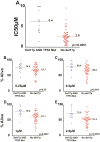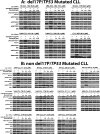Cell-Intrinsic Determinants of Ibrutinib-Induced Apoptosis in Chronic Lymphocytic Leukemia
- PMID: 27535981
- PMCID: PMC5315657
- DOI: 10.1158/1078-0432.CCR-15-2921
Cell-Intrinsic Determinants of Ibrutinib-Induced Apoptosis in Chronic Lymphocytic Leukemia
Abstract
Purpose: Ibrutinib, a Bruton tyrosine kinase (BTK) inhibitor, is approved for the treatment of relapsed chronic lymphocytic leukemia (CLL) and CLL with del17p. Mechanistically, ibrutinib interferes with B-cell receptor (BCR) signaling as well as multiple CLL cell-to-microenvironment interactions. Given the importance of ibrutinib in the management of CLL, a deeper understanding of factors governing sensitivity and resistance is warranted.Experimental Design: We studied 48 longitudinally sampled paired CLL samples, 42 of which were procured before and after standard CLL chemotherapies, and characterized them for well-studied CLL molecular traits as well as by whole-exome sequencing and SNP 6.0 array profiling. We exposed these samples to 0.25 to 5 μmol/L of ibrutinib ex vivo and measured apoptosis fractions as well as BCR signaling by immunoblotting. We disrupted TP53 in HG3, PGA1, and PG-EBV cell lines and measured BCR signaling and ibrutinib responses.Results: CLL samples demonstrated a surprisingly wide range of ex vivo sensitivities to ibrutinib, with IC50 values ranging from 0.4 to 9.7 μmol/L. Unmutated IGVH status, elevated ZAP70 expression, and trisomy 12 were associated with heightened sensitivity to ibrutinib treatment. Five CLL samples were substantially more resistant to ibrutinib following relapse from chemotherapy; of these, three had acquired a del17p/TP53-mutated status. A validation sample of 15 CLL carrying TP53 mutations, of which 13 carried both del17p and a TP53 mutation, confirmed substantially less sensitivity to ibrutinib-induced apoptosis.Conclusions: This study identifies that CLL harboring del17p/TP53-mutated cells are substantially less sensitive to ibrutinib-induced apoptosis than del17p/TP53 wild-type cells. Clin Cancer Res; 23(4); 1049-59. ©2016 AACR.
©2016 American Association for Cancer Research.
Conflict of interest statement
Sriram Balasubramanian is an employee of Janssen R&D, LLC.
Sami Malek owns stock in Abbvie.
Figures






References
-
- Spaargaren M, de Rooij MF, Kater AP, Eldering E. BTK inhibitors in chronic lymphocytic leukemia: a glimpse to the future. Oncogene. 2015;34:2426–36. - PubMed
-
- Stevenson FK, Krysov S, Davies AJ, Steele AJ, Packham G. B-cell receptor signaling in chronic lymphocytic leukemia. Blood. 2011;118:4313–20. - PubMed
MeSH terms
Substances
Grants and funding
LinkOut - more resources
Full Text Sources
Other Literature Sources
Research Materials
Miscellaneous

